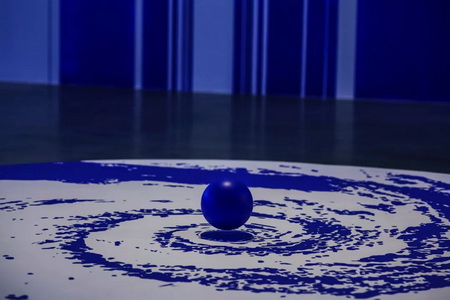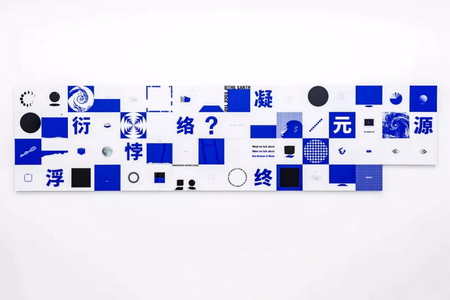文章转载至《典藏今艺术》2019.05/B
资料致谢北京单行道画廊

▲ 衍 Circle and Dandelions (2017)
28屏影像装置/17寸液晶屏/4分30秒/循环/彩色/16:9/无声
摄影:陈彦熹
无疑,丁世伟在单行道画廊呈现的最新个人项目“元”(2017-2018)将我们引入了一个时空交错的中间地带。让我们从一开始,沿着墙壁上延绵着的大面积、特定色值的深蓝不断向展厅内部回溯,艺术家将观众的注意力卷向一个特定仪式的巨大漩涡。在视觉上,丁世伟选用了非常显性的图示语言——圆与方,表达了自己对于基础几何的认知与兴趣。在作品《衍》(2017)中,艺术家通过网络与各大搜索引擎,生发与梳理了各类与圆相关的图像及文字。在屏幕内不断变化的逻辑线索与图像演化的对位过程之中,我们可以很明显地感受到:随着人类历史的发展与时间推移的演进,圆的形象被作为一种符号,又是如何被作用在相应的意识形态之下。
圆很完美,它是“正无限多边形”,而“无限”只是一个概念。我们可以想象“无限”——这种完美的形而上的终极体验:当多边形的边数越多时,其形状、周长、面积就都越接近于圆,所以,自然世界上似乎没有真正的圆。圆不仅仅很完美,它实际上还被抽象成为一种概念性的图形。当一个图形被日积月累的神圣化进而成为一个概念的主体,它所代表的,已然超越了形状与轮廓本身。因此,圆的进化史同时也是一段将人类想象不断神化的过程。那么,在作品《浮》(2018)中的圆与方未尝不是一尊需要被祭祀或参拜的神灵。

▲浮 Emerging Knowledge (2018)
装置/磁悬浮组件/布面丙烯/250*250*20 cm,282*282*20 cm
摄影:冯兮
人造正方形与圆形的出现根植于数学与几何,因为包含着人类对于“完美”的期待,它们似乎过于极致了。然而面对马列维奇在至上主义中所设置的方形信标下,丁世伟似乎有意选择了“悬置”这样一个中间状态。当我们注目于展厅内部,在画面上方不断旋转的圆与方,两者通过重力与平衡之间的微妙关系,正缓缓昭示出一种置身于悬置状态下引人注目的空白。而正是这份漂浮而来的空白,逐渐显现出了力学对于时间的基础定义:即揭示出一种运动的,变换的认知与关于完美本身——被留白的初始想象。

▲浮 Emerging Knowledge (2018)
装置/磁悬浮组件/布面丙烯/250*250*20 cm,282*282*20 cm
摄影:冯兮
在展厅高挑空间与零星的显示屏光源环境映衬下,作品《凝》(2017)体现出一种含混、被涂抹并难以判断的假设。此情此景,不禁让人联想到乔治•奥威尔的名著《1984》中知名的那句“老大哥正在看着你”。然而,模特的双眸被有意去性别化,又将作品的指涉笼罩出另外一层神圣属性:我们都还没有见过真神,因此我们似乎也难以判断出他们的属性,只知道在某种神秘主义的观点内,他们确实存在。那么,当我们凝视远方,近乎于深蓝的元色水平面逐渐趋于平静,发光的星球重新悬于夜空——这双眼睛也将一直盯着那片元色,正如我们对《终》(2017)点与起点那份一如既往的好奇,日出日落,永恒的时间更迭——不知道在我们凝视远方的同时,那些不知名的神灵本元,又将如何俯瞰与注目着我们?

▲终The Edge of theEarth (2017)
影像装置/65寸透明屏/定制水箱/8分44秒/循环/彩色/16:9/无声
摄影:陈彦熹
Suspension, gaze and the color of infinity
Text/WANG Zhiyi
Undoubtedly, Ding Shiwei's latest personal project What We Talk About When We Talk About Sea Horizon & Moon (2017-2018) presented in One Way Art Gallery introduces us intoa interlaced middle zone of time and space. Let's start from the beginning, tracing back inside the exhibition hall along the wall, through the large areasof the blue with specific tone, the artist draws the audience's attention to a huge whirlpool of a specific ceremony. Visually, Ding Shiwei chose the veryexplicit graphic language -- circle and square to express his cognition andinterest in basic geometry. In the work Circles and dandelion (2017), through the Internet and major search engines, the artist have collected and sorted outvarious images and texts related to circle. In the process of counterpoint between the changing logic clues and the evolution of images in the screen, we can distinctly feel: with the development of human history and the evolution of time, how the image of circle taken as a symbol is used under the corresponding ideology.

▲悖 Fragments of Civilizations (2017)
Single Channel VideoInstallation/Projection/5 Min 26Sec/Loop/Color/16:9/Slient
Photo by CHEN Yanxi
Circle is perfect, it's a positive infinite polygon, and infinity is just a concept. We can imagine “infinity” - the perfect, metaphysical ultimate experience: themore sides a polygon has, the closer it gets to a circle in shape, circumference, and area, so there seems to be no real circle in the naturalworld. Not only is the circle perfect, it's actually abstracted into aconceptual shape. When a figure is sanctified over time and becomes the subjectof a concept, what it represents is already beyond the shape and contouritself. Thus, at the same time, the evolutionary history of circle is a processof deification of the human imagination. If so, the circle and square in Emerging knowledge (2018) can also be a god that needs to be sacrificed orworshiped.

▲源The Oldest TV (2019)
Installation/Wireless Lunar Lamp/Magnetic Levitation/Waterproof Platform/Dimensions Variable
Photo by CHEN Yanxi
The appearance of artificial squares and circles is rooted in mathematics and geometry, containing the human expectation of perfection, they seem to be too extreme. However, in the face of the square beacon set by Malevich in the Suprematism, Ding Shiwei seems to deliberately choose the "suspension" such an intermediate state. When we pay attention to the interior of the exhibition hall, the circle and square that keep rotating above the picture are slowly revealing an eye-catching blank in the suspended state through the subtle relationship between gravity andbalance. And it is this blank floating out that gradually reveals the basic definition of time in mechanics: a moving, transforming cognition and about perfection itself -- the initial imagination left blank.

▲络 Relational Aesthetics (2018)
Digital Sketch/UV Printing/Acrylic/25*25cm*66
Photo by FENG Xi
Setagainst the tall space of the exhibition hall and the scattered light source environment of the display screen, the work Immortal gazing (2017) reflects a vague, daubed assumption that is difficult to judge. This scene is reminiscent of the famous line "big brother is watching you" from George Orwell's <1984>. However, the model's eyes are deliberatelyde-sexualized, so that the reference of the work is enveloped in another divineattribute: none of us have ever seen the real god, so it seems difficult for us to define their attributes, except that they do exist in some mystical view. Therefore, when we gaze into the distance, the water level with color close todark blue gradually calmed, and the luminous star hanging in the sky again -this pair of eyes will be staring at that piece of color, as we have thecuriosity about The edge of the earth (2017) - the ending point andthe starting point as always, eternal time alternates with sunrise and sunset - While we gaze into the distance, the origins of those gods with no name, how will they look down on us?

▲凝 Immortal Gazing (2017)
2-Channel Video Installation/3.5 Inch RaspberryPi/12 Min 42 Sec/Loop/Color/3:2/Slient
Photo by CHEN Yanxi

关于写作者
王智一 1991年出生于中国湖北,2014 年毕业于湖北美术学院壁画与综合材料绘画系,现居地未知。他关注色彩与图形在感知层面的象征与暗示,并藉此梳理人的心理与图像、声音及文本之间的联觉关系。
主要个展包括:《意义》,胶囊上海,中国上海(2018);《兴绘》,西五艺术中心,中国北京(2016)。曾参与群展:《墙势力IV》,时代美术馆,中国北京(2019);《界面效应》,今日美术馆,中国北京(2018);《再聚焦》,美术文献艺术中心,中国武汉(2017);抽象Q&A,星空间,中国北京(2016);《秩序的边界》,蜂巢当代艺术中心,中国北京(2015);轻抽象的星丛,UCCA当代艺术中心,中国北京(2014)等。
另有文章发表于艺术论坛,艺术界,艺术世界,艺术碎片,泼先生,美术文献等。
Wang Zhiyi was born in Hubei, China in 1991. In 2014, he graduated from the Mural and Complex Material Painting Department of theHubei Institute of Fine Arts, his current residence is unknown. The artistfocuses on symbolism and the implications of color and graphics in perception,exploring the relationships between human psychology and image, sound and text.
Selected solo includes:Meaning,Capsule Shanghai, Shanghai, China (2018); Painting IsPleasure, C5 Art Center, Beijing, China (2016). He has participated in thefollowing group shows:Becoming, TodayArt Museum, Beijing, China (2018); Refocusing, Fine Arts Literature Art Center, Wuhan, China (2017); Abstract Q&A, Star Gallery, Beijing, China (2016); The Boundaries of Order, HiveCenter for Contemporary Art, Beijing, China (2015); Soft Abstraction as Constellation, UCCA, Beijing, China (2014), etc.
Anotherarticle is published in the
ARTFORUM, LEAP, ART WORLD, ARTSHARD, PULSASIR, THE ART LITERATURE, etc.

关于艺术家
丁世伟 1989年出生于中国黑龙江,毕业于中国美术学院跨媒体学院,获硕士学位,现工作生活于杭州。
关注点涉及个人与集体、时间与生命维度、元悖论等命题,使用诸如动画、影像、装置、绘画、摄影等媒介进行创作。“项目”是其阶段性的工作方法,通常以2年为创作周期。他已完成的项目有“元” (2017-2018)、“陨歌” (2015-2016)、“乌托邦” (2013-2014),每个项目均包含多件作品。
他曾于2015年在法国克莱蒙费朗的PRIX VIDEOFORMES获得组委会特别奖,并在2014年荣获华盛顿华语电影节银奖。他的个展包括:北京单行道画廊的“元”(2019)和北京现在画廊的“破晓”(2016),以及荷兰乌特勒支中心美术馆的荷兰国际动画节项目“陨歌”(2016)和上海Mao Space的“西风凛”(2015)。参加的群展:中国美术学院的青年艺术家邀请展“在场”(2018);法国昂西城堡博物馆的“China, Art in Motion”(2017);澳门艺术博物馆的“叙事曲-动漫美学当代艺术展”(2017);意大利都灵Castello Di Rivara当代美术馆的“Utopia & Beyond”(2016);巴黎和柏林的“Les Rencontres Internationales”(2015); 中央美术学院美术馆的“未来展”(2015)。他的短片作品也在众多国际电影节展出,曾入围法国昂西国际动画节(2017)、荷兰国际动画节(2016)、鹿特丹国际电影节(2015)、坦佩雷电影节(2014)等的国际竞赛和展映单元。
Born inHeilongjiang in 1989, DING Shiwei graduated from the School of Intermedia Art, China Academy of Art with a master’s degree. He currently lives and works inHangzhou, China.
Hefocuses on such topics as individuals and collectives, the dimension of timeand life, the meta-paradox, creating with the media of animation, video, installation,painting and photography. He works in the way of phased “projects”, whichusually last for two years. His completed projects include “What We Talk AboutWhen We Talk About Sea Horizon & Moon” (2017-2018), “Meteor Sonata”(2015-2016) and “Utopia” (2013-2014), each containing multiple works.
DING Shiwei won the silver medal at the D.C. Chinese Film Festival in 2014, and the PRIXVIDEOFORMES Special Award in 2015 in Clermont-Ferrand, France. His solo exhibitions include “What We Talk About When We Talk About Sea Horizon &Moon” (2019) at One Way Art Gallery, Beijing; “Daybreak” (2016) at Beijing ArtNow Gallery, Beijing; the project of “Meteor Sonata” (2016) in Holland International Animation Festival at Central Museum , Utrecht, the Netherlands; and “Disparate Illusion” (2015) at Mao Space, Shanghai. Group exhibitionsinclude “Presence” (2018) – the Invitational Exhibition of Young Artists ofChina Academy of Art, Hangzhou, China; “China, Art in Motion” (2017) at Musée-Chateau, Annecy, France; “Ballade – Animamix Contemporary Art” (2017) atMacao Museum of Art, Macao; “Utopia & Beyond” (2016) at Castello Di Rivara Center for Contemporary Art, Torino, Italy; “Les Rencontres Internationales”(2015), Paris and Berlin; “CAFAM Future Exhibition” at CAFA Art Museum,Beijing, China. His animated short films have been screened in multipleinternational film festivals, including Festival International du Filmd’Animation d’Annecy, France (2017), Holland International Animation FilmFestival (2016), International Film Festival Rotterdam (2015) and Tampere FilmFestival (2014), etc.
【声明】以上内容只代表原作者个人观点,不代表artda.cn艺术档案网的立场和价值判断。

